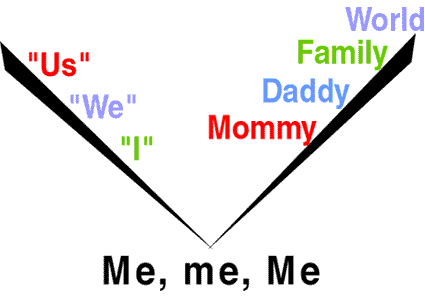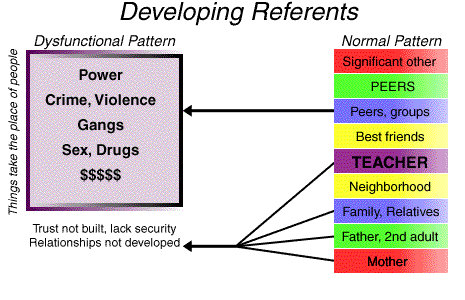





 |
 |
 |
||
 |
 |
 |
||
|
|
|
|
|
|
| Home : Humanistic Module : Online Reading 4 | ||
Human Being, Human NatureAutonomy and Heteronomy It is important to know what makes a person feel and behave in specific ways if we hope to support growing into a stable and successful adult. It is vital to be able to recognize patterns of behavior as well as motives for behavior, both common patterns and expected responses, idiosyncratic possibilities and behaviors that signal distress or dysfunction. By recognizing the human nature elements common to youngsters, to human beings, we can facilitate growth and development. The end result is not just a change in the classroom or the family, but a permanent systemic change in the way parents, teachers, children and society view the learning and growing process. It is a great help to personal growth, the healthy development of our own families and the world community. What is the basic nature of people? What drives children? Two concepts keep asserting themselves through philosophy, religion, literature, the studies of man. These two intertwining dimensions of human nature are basic to understanding self and society. As dynamic sources of human energy, they are like two magnetic forces, alternately repelling and attracting, that make up the "motor" or driving force of each individual's humanity and the social fabric of a society. When the two forces are working in concert, a balanced personality is the result. When one force becomes an exclusive focus, there is a dysfunctional effect.
The behaviors on the autonomous or self absorbed side are those that are most distressing for others and more invasive, harder to value in relationship in the classroom or in community. Although the behaviors on the heteronomous side are less distressing to others, it is not in a human being's best interest to give too much of self away, to lack a vision of self or fail in the attempt to protect the special gifts that are uniquely that entity's. Some youngsters seem to tend toward one extreme or the other from the first moments of life. Some cling to that position throughout life. Most of us are propelled from one extreme to the other in a slowly developing spiral. The basic part of human nature is closely linked with ego or self development. The self is an interesting paradox for human beings, for we are, in fact, ourselves from birth, yet our self develops more fully over time, as we become more cognizant of who we are, who we wish to be, and as the fabric of our social surroundings imprints itself upon us. We are creatures who develop, redevelop, reach a point of stasis and then reach beyond ourselves. We are compelled at once to meet our own needs, yet even in early childhood are moved by the needs of others and alter our own course to attend to those necessities. We feel fully functional and shout to others of our maturity at twelve, in our brashness and certitude. Yet we are uncertain in our certainty, anxious enough that we protest the names like youth, adolescent, youngster, that would suggest we are not at the pinnacle of growth. Vocalizations tell the tale. At two, we proclaim, "Me do it." At four we respond to offers of assistance with "Leave me alone." At ten, we announce, "I know." At fourteen, we pout or rage at instructions, and decry any hint of imperfection or lack of wise choices. At forty, we begin anew, striking off in unfamiliar territory, certain of ourselves and disappointed with the lack of vision from those around us. We are filled with hope, with faith, with a need to create ourselves. We are filled with frustration, disappointment, a need to be valued by others in the way we believe we can be valued. We are turning, turning, turning. We are reaching, reaching, yearning. We are always and never enough for ourselves. We are always and never quite satisfied with who we are, and filled with hope for who we are becoming. Thus we see that esteem of self is impelled by that same autonomy, heteronomy motor. Self-esteem is a complex part of being a person. There are at least two primary facets to self-esteem.
I. The Infant is born with a personality and esteem When children are born they have a great supply of self worth. Infants are born "being" great. We believe through some inborn expectation, that we deserve to be fed, protected and nurtured. Infants express rage and disbelief when those deserved things are not forthcoming. Further, somehow, we see ourselves as a being with power -- unquestioningly. The self-esteem that has to do with "being" is almost ineradicable -- it appears to be part of the will to live, and a great deal more we have yet to understand. The BEING form of self-esteem can be damaged with respect to the outlet it will take for self expression, but it does not appear to be readily accessible to destruction. Generally new infants don't have to DO anything to be wanted and loved. Their simple presence is a reason for pleasure. This doesn't last long. As soon as the parent determines that the child's behaviors are interfering with life, expectations of DOING begin to appear. The parent wants the child to sleep through the night, to be appeased when comfort is offered, to be less controlling and disruptive in the family. After all, anyone who has gone through the regiment of change which a new baby's demands create, knows that at first, the baby, and no one else in the family, "is wearing the pants!" Further, the demands are inconsistent and create a feeling of chaos and unscheduled crisis for a parent who used to feel a sense of control over time, resources, life. Because the infant is so helpless, and is biologically made to appear lovable (Harlow & Zimmerman, 1959 ) parents generally learn to juggle their own needs while training the child to fit into the family needs and schedules. In effect, the parents learn ways to train the child to DO without sacrificing the child's well BEING. Success in this process includes consistency and structure as a part of the high expectations or demands (Coopersmith, 1967). The more loving and nurturing the parent, the healthier the child's sense of DOING will emerge and the more fully the being and doing will compliment one another. The child learns to believe s/he can trust the parents, and thus the environment and to believe there is safety and warmth to life. The foundation for a healthy personality, good ego strength and resilience is thus developed for a child. II. As we mature we are constantly drawn to have our own way and find a counter energy in wishing to please those we love or need. The infant begins the cycle from an autonomous (child is seeing and getting own way) perspective having total concern with self, to a more heteronomous (awareness of the presence of "otherness") perspective. Thus the child begins to be socialized. Having learned to adjust to the needs of the parent, usually unwittingly, the child has made the first cycle toward socialization. It is an ongoing journey, not a static accomplishment. 
This process of socialization is only begun in infancy (Brazelton, 1969). We repeat the cycle over and over again as we grow. The child who has been successfully trained to control the most essential body functions continues to grow emotionally, and by the age of two, has come full circle and demands total autonomy once again. It is the province of the two-year-old child to insist on having one's own way, to win at a clash of wills, to 'worship at one's own feet." It is a normal human stage to be grown out of, and then revisited periodically and less emphatically throughout life. That stages is certainly descriptive of the middle school student and explains much of the behavior and response set of the early adolescent. Typical developmental ages for focusing on autonomy include 2,4, 7, 9, 11, 13, 15, 17. The behavior of a thirteen-year-old is ideal to illustrate autonomous behavior. The youngster recognizes self as person and has a tremendous drive to get personal needs and desires met. The drive is so strong that the child may propel self in dangerous ways, despite the wishes or needs of those around. At every turn the child displays that autonomous perspective. Every request to the child generates an initial internal "NO!" Sulking, passive aggressive responses and anger are markers that the young adolescent feels thwarted. The immediate response tends to be an internal dash to overcome restraint, not so unlike the response of the two-year-old. The ability to perceive the needs of others is unused and unimportant as the child presses for immediate gratification and control. Parents of young adolescents often express frustration, depression, even hopelessness, as the child refuses to comply, to be friendly, to be appeased. If people successfully grow beyond adolescence, we see autonomy emerge as a part of the crucial forces again in adult lives about every seven years. We often see adults working through autonomy at around 29, again in the 40's - mid-life crisis, and continuing on into elder years and culmination of generativity. It is not lost in emotionally healthy adults, but becomes mitigated and provides energy and an anchor in the development of unique gifts and skills, a force to maintain joie de vivre. III. Healthy esteem is a result of successfully balancing personal needs and the needs of others - being and doing. Most people learn to successfully adapt their wishes around the wishes and needs of others. The intense periods of personal demanding become tempered. The child's recognition develops that self and others pay a harsh price when no credence is given to the unfulfilled needs of others; loss of friendship, feeling of alienation, lack of positive response to requests or manipulations. The child hopefully learns that one can best achieve personal needs and succeed with personal goals by attending to the people around them and balancing self gratification with the needs of others. This is a complex picture of self-esteem. It is vital to see how these facets of the person's emotional development mesh so that educators and parents effectively build the child. It is ineffective and self defeating for a society or an individual to continue to believe that correcting children and structuring educational experiences will ultimately result in emotional harm. To provide the best growing and learning environment for students we must understand then pass a recognition along of the socializing difference between 'right to be' and 'right to do to others'. IV. Some esteem messages carry more weight than others. Another component that is a part of the rounded concept of self esteem might be called referent source, or who a person tends to listen to in defining personal value. This link to valuing the self is an emerging and developmental dimension. In infancy the mother is the initial source of information about personal value and the trustworthiness of the world. As time goes on and the child's social circles broaden so also do the voices a child attends to as a function of emotional progress. Usually the child's need to be valued by others expands to include another adult - most frequently the father, at around 18 months of age. The pattern may be influenced by the culture and social surroundings. Thus, a child being raised by an extended family will bond or "refer to self through others" within the family first, and then extend to neighbor children or those attending the same day care, with cousins, with siblings. The pattern is fairly set, that the child will define the trustworthiness of surroundings based on the ministrations of the adults initially, and then move to children. Until at least age four, most children do not really "hear" messages from peers. Until preschool age most play is unilateral, even if children are sitting together. As noted in the following chart, that changes little by little, with friends becoming more important and then crucial by the time a child is in third or fourth grade. Children who are "street-wise" may turn to same age children as early as second grade, but that is done out of need for some human source of reassurance. By middle school and high school, peer messages become critical, and for some youngsters, those communiques are the only ones of value, the true measure of who and what matters. A large number of today's youngsters appear to be growing up without making connections with others; perhaps associating with television characters, sometimes showing failure to thrive, withdrawal, depression. Many seem to be drawn to "things" for a source of self stimulation and self gratification. Examples of substituting a thing for a person as a referent may be money, drugs, sex for the sensation, video games, thrill seeking or cars. [Liking and engaging in these things is not the same as using them as a substitute for human engagement or companionship]. For this reason, the role of teacher is almost sacrosanct, since it can span a child's entire lifetime and can actually replace some of the human referents previously missing for the child. If a child arrives in kindergarten having made no other attachments, it is possible for the teacher to fill that need and to give the child a strong voice of affirmation, a bond, a sense of well-being and kinship to the wealth of joy in human relationships. Certainly many children who have made good bonds and have excellent self-esteem attach to the teacher, even calling her "MOM" and giving mother the teacher's name. Which parent has not heard: "Mr. Jones, I mean Dad, can I go now?" To recap, the infant is attuned to the messages of the mother, and then the father. As development continues, the child grows to need the assurances and expressed pleasure of playmates. The child enters school and moves beyond the immediate valuing of the family. It becomes important to be recognized as a valued "doing and learning" person who is validated in the school (doing) setting. This is one of the greatest responsibilities (powers) educators have.
Since most children are not cognitively able to tell the difference between right and wrong until age eight or nine, some children fail to fully develop and thus become under socialized adults. The peers, primarily gangs held together by similar feelings of social unworthiness, do not provide lasting or consistent messages to each other and CANNOT become positive sources of high self-esteem. Under socialized youngsters, those who have not established a sense of trust in others, typically seem unable to develop relationships with people. Instead, they appear to move toward defining themselves with "things". Obtaining money and wealth, regardless of using legal or illegal means, is used to shore up and define self worth. It gives a sense of power. Still others adolescents define self worth through a sense of might - physical, emotional or spiritual power over fellow beings. Some turn to stimulation - sex for sensation rather than relationship, mood altering substances, food, the adrenalin rush from speeding, daring, falling from heights, fighting, killing. In spite of the fact that most adults will have little value as a referent source to adolescents, the teacher, (coach, advisor, band director, English instructor, shop or Home Ec. advisor, Science or lab assistant) may continue to influence the student and be valued as a source for legitimately reinforcing emotional well-being, for helping youngsters develop relationship and recognize the impact of their actions and gratification seeking on those close to them as well as the impact on society. The task is a difficult one. Since these children tend to be "unlikable" and 'unreachable" by the time they have reached adolescence, we tend to allow ourselves to unconsciously shut them out of our emotional view. Since they are unable to build and sustain relationship and unable to see how their behaviors impact others, building relationship is initially thankless. By their demeanor and poor socialization skills, they strike out at and hurt those who try to show caring and concern. Through lack of trust, they tend to misread caring and nurturing, to look for weaknesses to expose in those who show respect for them. 
The mistrust and striking at others is one way of coping with the loss of the internal sense of worth, of internally defining and responding to "being" undeserving of attention, thus looking for defenses rather than accepting the love and concern we are expressing. It is the sense of “being” damaged, but not negated entirely. Like a drowning person, the psyche clings to any overhang or proffered assistance, but with such fierce need that the source of assistance may be pulled down, as well. Despite the lack of reinforcement and acceptance of the initial efforts to build relationship and express positive regard, it is never too late to make a difference in children's lives. Though it may be years later, though we may never personally know the impact, it is certain that if we are to help children live effective and meaningful lives, they must learn social skills, social perspective, trust. If they are to contribute, they must find peace and acceptance of self. If the adolescent progresses in a normal fashion and youngster begins to search for meaning in giving to others, and eventually will define self through a love interest and a significant other, a boy/girl friend, building a permanent intimate bond. Frequently the teacher, coach, band director, sponsor, will be an adult the student will turn to for advise and guidance, even when the relationships are shaky at home. Collect
a Once you have completed this topic you should: Go on to
Assignment 2
|
||
| E-mail J'Anne Ellsworth at Janne.Ellsworth@nau.edu | ||
|
Course Created by J'Anne Ellsworth & Center for Technology Enhanced Learning Copyright
© 2001 Northern Arizona University |
 |
 |
 |
 |
 |
|